12 Body-Positive Yoga Cues You Can Use in Common Poses
This article originally appeared on Yoga Journal
For years, I struggled whenever yoga teachers cued me to step my foot in between my hands. The transition felt clunky and awkward in my body. My arms were too short, my belly got in the way of my knee, and everything felt squished and compressed. As a result, I would wobble and come into an off-balance lunge that made every posture following that even more difficult. I came to think of this transition as "the dreaded step-through," even after I became a body-positive yoga teacher and instructed students through that same transition.
That changed the day a teacher cued me to step forward from Downward Dog by placing my right foot to the outside of my right hand rather than the typical cue of "step forward between your hands." Bam! Just like that, with almost no effort, my foot landed in position and I was able to ease into a high lunge that felt strong and comfortable.
Ever since then, I take the time to break this transition down for students. Sure, if you can get your foot between your hands, go for it, I tell the class. But I am always careful to also cue stepping your foot to the outside of your palm and creating some space. Then I remind everyone to take a moment and set up a strong and comfortable stance before they come into a lunge.
For me, the difference was truly life-changing and allowed me to experience my practice entirely differently. As a student and a teacher of yoga, I'm reminded each day just how important it is to cue variations. Small body-positive yoga variations offered alongside traditional instructions can help bring everything into place and help everyone in the class feel seen as well as capable, good, and strong in their own bodies.
It’s our responsibility as teachers to change up our instruction with tweaks or variations so we can speak to all bodies in the room. This helps everyone feel empowered to take an option that feels right for them. I believe that if my cueing has landed in a new way for at least one student, then I have done my job well.
How You Can Cue Body-Positive Yoga
When I was new to teaching, I was given the terrific advice to practice each posture I planned to teach in class and think about the areas where someone might feel compression in their bodies--and then cue some of the body-positive yoga variations that could alleviate that pressure.
For example, you can suggest to students in Downward Dog that they place their hands on blocks to create a little more space when they step their foot forward underneath their body.
What feels good in my body is going to look different than what feels best for you. That’s why you'll never hear me say "the full expression of the pose" in my classes. There is no such thing. There is only your expression of a pose. This goes for folks in bigger bodies, but also people who are less flexible, have different proportions, or are working with injuries.
Following are a few common yoga postures and effective ways to change your cueing to create a more body-positive yoga class. Not a yoga teacher? Try these versions in your next practice to see if any of them make a difference for you.
12 Ways You Can Create A More Body-Positive Yoga Experience
This is not an exhaustive list of body-positive yoga cues. Rather, it's something to help you think about the ways you can incorporate new instructions, props, and transitions into your classes and your practice.
Eagle Pose
I like to think of Eagle Pose (Garudasana) as my personal nemesis pose. For someone with tight shoulders or a larger chest (I am blessed with both!), the arm portion of the pose can be especially challenging. Same goes for the lower body and anyone with shorter legs or larger thighs (again, a double whammy for me). There simply isn't enough space to make the pose work.
If you can cross your arms and the backs of your hands connect, great. If not, that's also great.
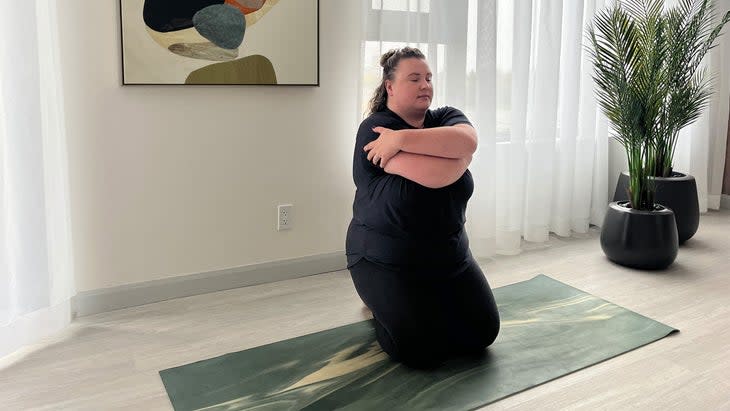
1. Instead of wrapping your arms around each other, I like to cue to reach across your chest for your opposite shoulders and give yourself a big hug. Then relax across the backs of your arms and neck.
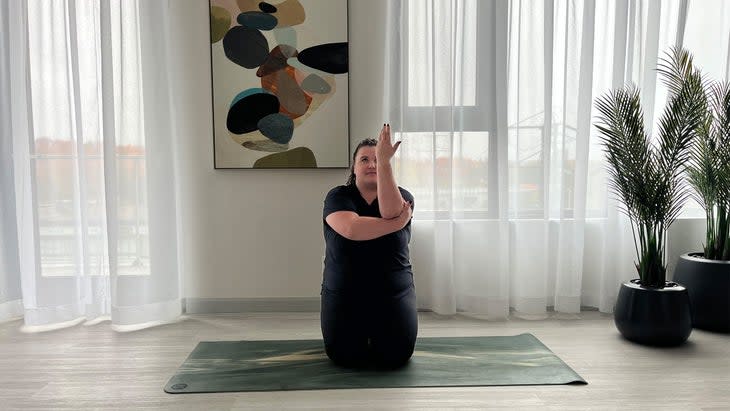
2. You can instead keep holding onto one elbow and lift your opposite hand and fingers toward the ceiling. If you have tight shoulders, you'll probably find that you get enough of a stretch.
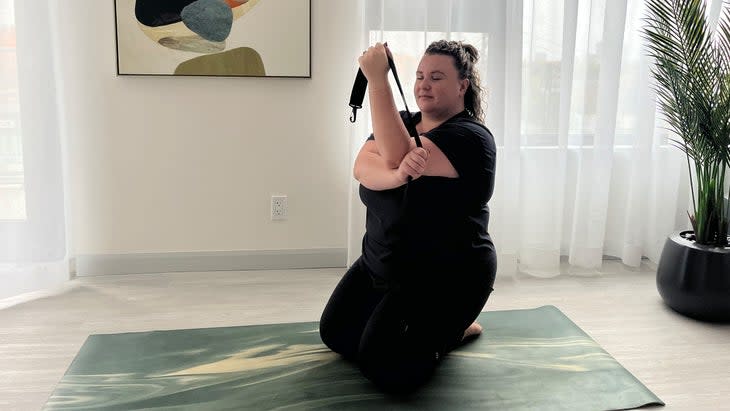
3. A version of Eagle arms that I find empowering is to use a strap. For this version, you'll need to hold on to the strap in one hand, cross your arms as much as possible, and grab the free hanging end of the strap with your opposite hand. Grasping a strap is also helpful for anyone who can access Eagle arms as the strap can provide a little more tension and pull. However, this version can be a little tricky to get into on your own.
Teachers: When I cue Eagle arm variations in class, I will often walk the room with a strap and place it in a student’s hands for them.
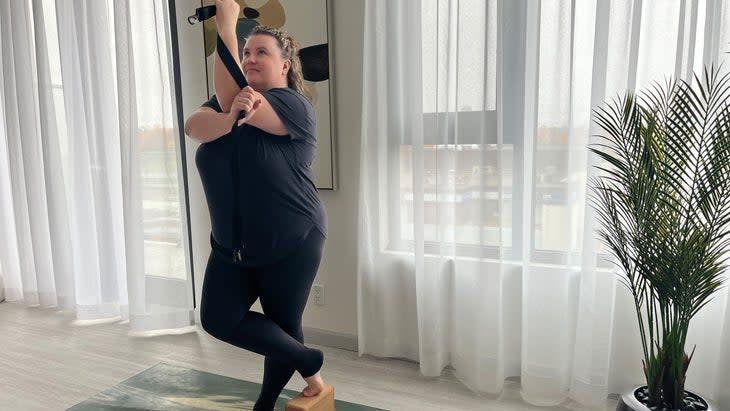
4. For Eagle legs, I like to cue everyone to place a block to the outside of their left foot. Pick up the right foot and place the toes on the block. Think about squeezing the thighs together. You may then start to wrap your toes around the back of your calf--or not.
Seated Forward Bend
This is another pose that is challenging for a lot of people. Think about where someone might start to feel compression in their bodies as they lean forward. For a lot of people in bigger bodies, we're actually more flexible than we are able to demonstrate because our body starts to run into itself and we get stuck.
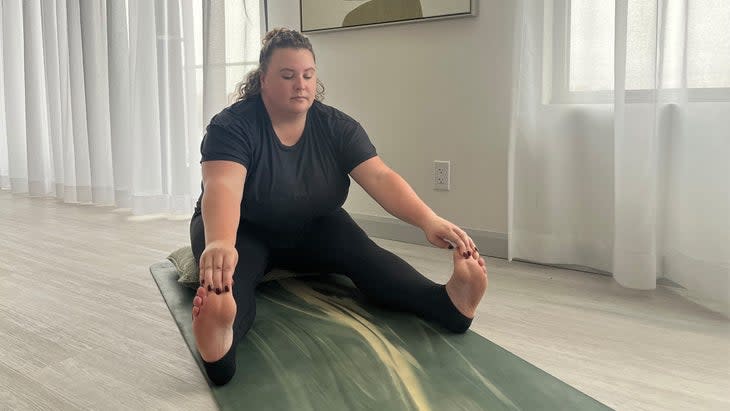
5. In Seated Forward Fold, I cue to bring the legs about shoulder-width distance apart, and then reach to fold forward. By creating an opening between the legs, you are providing more space for your chest and belly to fold forward without running into your legs. It can also be really helpful here to sit on a block or bolster to get a little more lift through the hips.
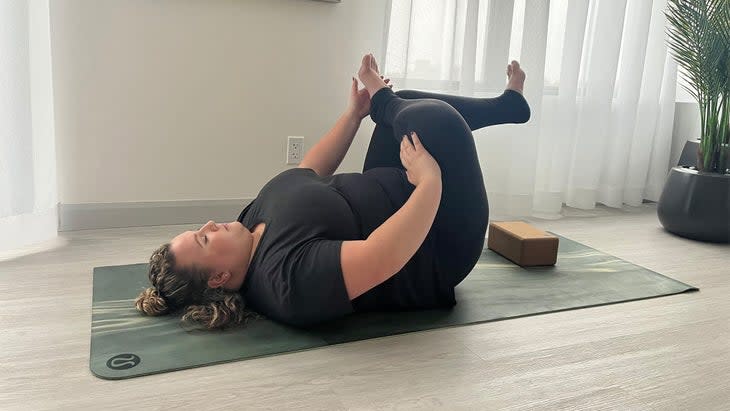
Reclined Figure Four
Reclined Figure Four is another postures where someone might experience compression. 6. Instead of reaching for your shin, I like to suggest that students reach for whatever they can connect to--their shin, thigh, foot or knee. They can also use a strap threaded on the thigh or foot.
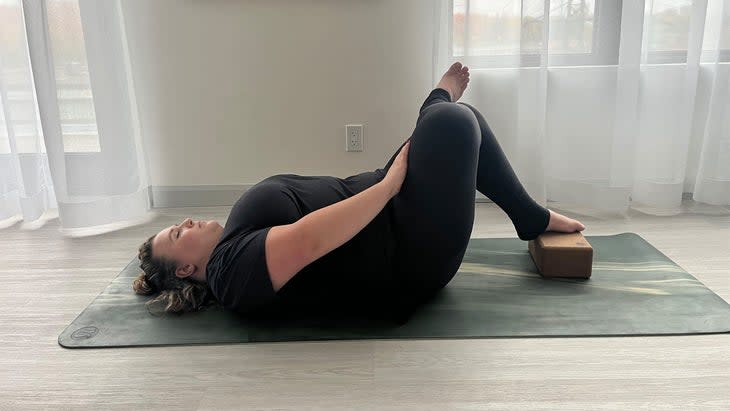
7. Another great option is to place a foot on a block or on the wall. This way, you can use the wall for support to add tension and intensity to the stretch, without worrying about actually reaching for your leg.
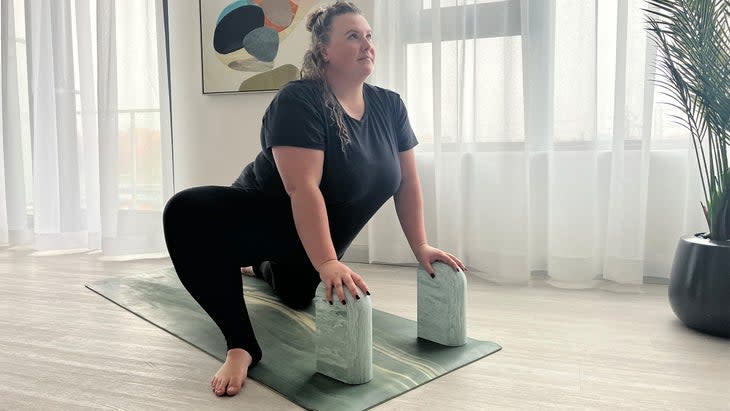
Low Lunge
As I've mentioned, lunges can be challenging for people with shorter arms or more abundance along their front line. Since lunges aren't uncommon in most yoga classes, it's important to think about where someone might feel compression and provide options.
8. As often as I can, I try to remind students to step their front toes away from their body. By heel-toeing your front foot open, you create more space for your body to hinge forward. I also like to cue hands on blocks to create more space between the front thigh and belly.
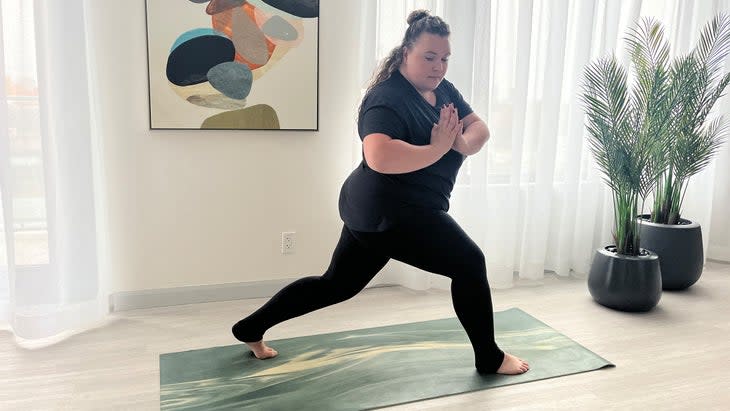
Revolved Lunge/Standing Twists
Twisted shapes can also be inaccessible or uncomfortable for people in larger bodies.
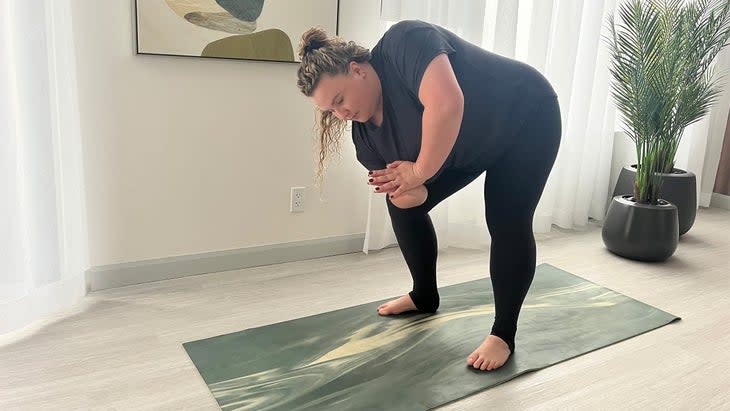
I have pretty much dropped the cue of hooking your elbow against your opposite knee in a twist because for a lot of people, their body gets in the way.
9. I prefer to cue body-positive yoga twists starting upright in a lengthened out position--arms stretched out wide--to give people as much space as possible. If I'm teaching a Revolved Chair Pose, for example, I'll cue to twist as far as you can and then maybe hook your elbow onto whichever knee you can.
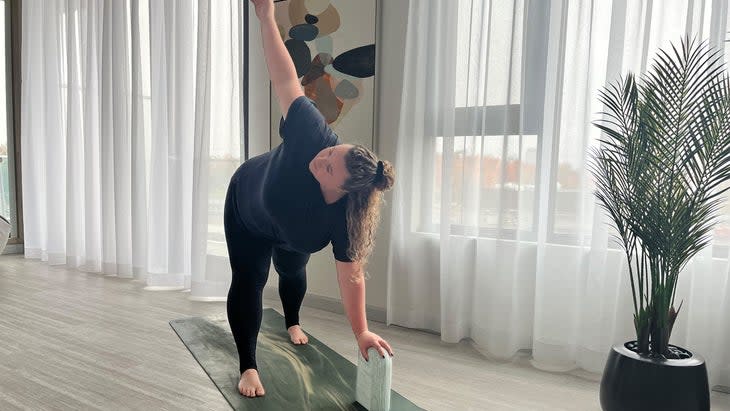
Revolved Triangle
Revolved poses are another form of twists. It’s important to keep in mind where you can create space in the body to move. 10. Personally, I love a Revolved Triangle Pose with a block underneath the bottom palm for a little extra lift. You can even stack two or three blocks as needed.
Stepping Through to Downward Dog
11. Of course, I also offer students the option to step their foot to the outside of their hand.
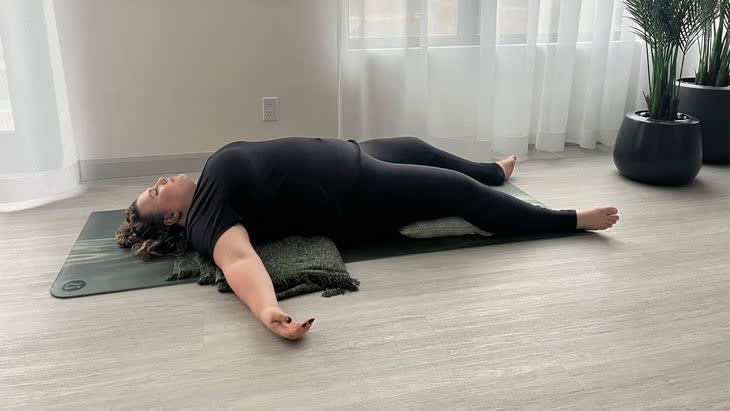
Savasana
People are always surprised to hear that traditional Savasana, or Corpse Pose, is not the most comfortable posture for a lot of people. 12. I'm a big believer that students can choose any shape they like for their closing Savasana--on their back, side, stomach, even seated. A slight tweak can go a long way in making the pose more accessible and comfortable. That could look like your knees bent with your feet on the floor and your knees resting against one another or sliding a bolster underneath your knees or your low back (why not both!). The key is to tuck props anywhere the body curves away from the ground to feel supported.
About Our Contributor
Ellie Sheppard (she/her) is a yoga teacher based in Ottawa, ON, with a passion for creating safe welcoming yoga classes for all bodies and experience levels. Coming from a background in dance, Ellie was first drawn to yoga as a way to integrate movement and creativity back into her life with a mix of strength, stability, and mobility for injury prevention. Ellie is a firm believer that there is no full expression of any yoga pose--there is only your expression of the pose. Her mission as a teacher is to encourage students to explore their own expression of a pose so it feels good and welcome in each individual body. Outside of yoga, you might find Ellie falling off her paddleboard, tap dancing, and spending time at local coffee shops, breweries, and vineyards.
For exclusive access to all of our fitness, gear, adventure, and travel stories, plus discounts on trips, events, and gear, sign up for Outside+ today.

